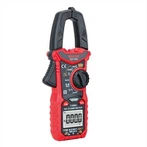Working principle and operation steps of insulation multimeter
Overview: The insulation multimeter is used by technicians to test the insulation resistance of conductors, electrical parts, circuits and devices to: verify the quality of electrical equipment, ensure that equipment meets regulations and standards, determine changes in equipment performance over time, and determine the cause of failure. A functional instrument.
1. The importance of insulation resistance measurement
Maintenance technicians use insulation resistance testing to minimize the chance of equipment failure or failure and maximize productivity. At the same time, it can also prevent the occurrence of dangerous accidents such as electric shock and fire, and ensure the personal safety of employees.
2. Insulation resistance measurement process
1. Before using the insulation meter for testing, technicians must first perform basic voltage, current and resistance measurements.
2. After the equipment is de-energized, use a FLUCK insulation multimeter to determine the integrity of the windings or cables in motors, transformers, and switchgear. Insulation resistance measurement and leakage current measurement are carried out on insulating materials to produce an insulation resistance value, see Figure 2.
3. Safe operation
(1) Before the test
1. Work on de-energized circuits where possible, employing proper lockout/tagout procedures
2. Assuming that the circuit under test is live, use appropriate personal protective equipment and safety tools.
3. Take off all jewelry, and stand on the rubber insulation.
(2) When testing
1. Do not connect an insulated utility meter to live conductors or live equipment, and strictly follow the manufacturer's recommendations.
2. Turn off the device under test through an open circuit fuse, switch or circuit breaker. Lock and tag the device under test.
3. Disconnect the branch lead, ground lead, and all other equipment from the unit under test.
4. Discharge the conductor capacitance before and after the test.
3. Matters needing attention
1. Check for leakage current through all fuses, switchgear and circuit breakers in the de-energized circuit. Leakage currents can cause inconsistent and erroneous readings.
2. Since the instrument will generate an arc when the insulation is damaged, please do not use the insulation resistance tester in a dangerous or explosive gas environment.
3. Do not use insulation resistance testers on electronic devices.
4. Please use insulating rubber gloves with leather protection when connecting the test wires.
4. Maintenance principle
(1) When equipment is installed and updated
It will avoid wiring errors and defective equipment in the system, ensure high-quality installation, and prevent electric shock or equipment from causing fire.
(2) Eliminate danger
By performing a high-voltage insulation resistance test between a current-carrying wire and a ground wire, maintenance personnel can eliminate the possibility of dangerous shorts or shorts to ground.
(3) Preventive
Routine monitoring of insulation resistance values using an insulation multimeter can provide information on the state of insulation degradation and ensure timely repair or replacement of equipment.






